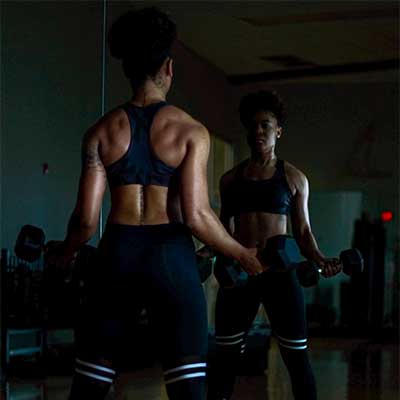Last Updated on February 16, 2025

The world of fitness has many dos and don’ts. With so much contradictory information out there, it can be overwhelming to choose which guidelines to abide by for optimal results. While some might be scientifically proven facts backed up by years of research, others are just plain old myths. It is very important to dive into the science and veracity behind various claims.
As a fitness trainer, I’ve personally encountered several clients who hold back because of some information that they might have read on the internet or heard from a friend. That is why I decided to compile a list of eight of the most common fitness myths and misconceptions. Hopefully, busting these myths will better guide you through your fitness journey.
- I Just Want to “Tone” My Muscles
- Avoid Weightlifting If You Want to Lose Weight
- Women Will Get “Bulky” If They Lift Weights
- Women Need Different Exercises Than Men
- Low Intensity, Long-Duration Cardio Sessions are the Way to Go
- More is Always Better
- You Can’t Build Muscle on a Caloric Deficit
- Running is Bad for Your Knees
- Conclusion
I Just Want to “Tone” My Muscles

If I had a dollar for every time I heard this during my professional career, well, I would be rich.
This statement which you might have heard (or even used at some point) is physiologically incorrect. If we were to take a look at the anatomy of the human body at a musculoskeletal level, we would see that our muscles are already striated, meaning they are toned and defined in nature. This is already the case for everyone!
What happens is that fat accumulates and surrounds the muscle, and we can end up losing that toned look. Not to worry – once you start losing body fat, your muscle definition will reappear again!
Avoid Weightlifting If You Want to Lose Weight

Another one of the most common fitness myths is that people looking to lose weight should avoid stepping foot in the weight area. This is completely absurd for several reasons. First off, when you weight train, you’re going to gain muscle mass, which in turn will increase your metabolism at rest, since muscles need energy to survive. This means you’ll be burning more calories than before!
In addition to that, weight training triggers the release of stress hormones, which promote weight loss! Not to mention the positive effects weightlifting has on increasing bone density and preventing osteoporosis and other degenerative diseases.
Women Will Get “Bulky” If They Lift Weights

“Stay away from the dumbbells or you’ll get too big”. Yet another untruth, and here’s why.
Physiologically speaking, women have lower testosterone levels at a hormonal level than men. Testosterone is a highly anabolic hormone responsible for gaining muscle size.
However, this does not mean that females cannot put on muscle; they just won’t (on average) as quickly or as much as men do. That can change, of course, if they’re following a well-designed strength program and eating a caloric surplus.
Another important point to keep in mind is that the goal of weight training isn’t only about aesthetics. It’s the translation of the work put in the gym into daily life. Lifting weights will help make a lot of daily tasks easier and more efficient. This can include a lot of everyday tasks, such as carrying groceries, lifting something heavy off the ground without hurting your low back, etc.
Women Need Different Exercises Than Men

Now, this is just plain ridiculous. No, women do not need to train differently. And no, there are no magical exercises that’ll transform your body quicker.
Our musculoskeletal systems function the same way. Our bodies react to stimuli and mechanical work. What you do need to pay attention to is the “one size fits all” approach, meaning someone else’s workout routine may not benefit you as much as it benefits them. Find out what works best for YOU.
Low Intensity, Long-Duration Cardio Sessions are the Way to Go

Let’s break this one down once and for all. Our body uses lipids (fat) as the predominant fuel for low-intensity, long-duration exercises, while high-intensity exercises use glycogen (carbs) as fuel.
However, there’s a constant continuum between the two. As intensity increases, the body tends to shift towards carbs for more energy during harder bouts.
Recent studies show that HIT (high-intensity training), intermittent training, or HIIT (high-intensity interval training) have had more promising results when it comes to weight loss.
If we were to approach the matter simply by calculating the number of calories entering your body vs. the number of calories burned, shorter intervals of near-submaximal effort (HIT) would burn more calories than walking or pacing on a treadmill.
This does not mean that low-intensity cardio is bad. It is, in fact, good for overall longevity and can also be used as a recovery method from tiresome HIIT sessions.
More is Always Better

People have developed this idea that if they do more than what’s needed, they’ll get to the finish line faster. Wrong! It might just lead to a setback.
Approaching training and the human body with this sort of mentality can have serious detrimental effects, such as overtraining.
Many people out there aren’t on board with the idea of overtraining, but I can assure you this isn’t another myth.
It is during our rest period that our bodies recover and repair. If we fail to provide sufficient rest, then our performance will suffer, potentially leading to unwanted injuries.
Research has shown that our bodies react to a certain volume of work. This volume can be split. Instead of performing 10 sets of eight repetitions of squats on a single day and placing significant stress on your lower back and knees in a single session, you can split the workout over two days. For example, try four sets of 10 repetitions per day. This will lead to the same volume of work done at the end of the week.
Train smarter, not harder.
You Can’t Build Muscle on a Caloric Deficit

Perhaps you’ve heard that “you can’t lose fat and build muscle at the same time” or “you need to bulk up and be on a caloric surplus to build muscle”.
All of these statements are false, and here’s why.
Muscles are mainly made up of water and amino acids (protein). To gain muscle, we need adequate water and protein consumption (at least one gram per pound of body weight) as well as the stimulus to grow (training via progressive overload). Therefore, I recommend you stop eating everything in sight and claiming that you’re bulking because you’re just gaining fat. Doing that would not only be hard, but it would additionally just be a waste of time to lose all the weight you put on.
Yes, not being able to build muscle on a caloric deficit is one of the common fitness myths. However, you need to keep in mind the degree of this deficit.
Let me explain: if your Basal Metabolic Rate (BMR) is about 2,000 calories and you’re on an 800-calorie diet, then the results will be different since you won’t have the energy required to train and build muscle. However, if you were on a 1,700-1,800-calorie diet (still in a slight deficit), you will be able to train and stimulate muscle growth.
Running is Bad for Your Knees

Walking and running are the primary and basic movements of the human body. To generalize the idea and boldly say that running is bad for your knees is incorrect. This implies that endurance athletes, such as marathon runners who run 26+ miles, must suffer from knee pain, which is not the case.
As is the case for any other exercise, running requires proper preparation and technique among other things. Yes, running has a technique to it. Correct biomechanics and balance in the lower body musculature are required, not to mention the terrain used and the footwear worn. If you’re running on concrete with poor mechanics and improper footwear, then it’s no surprise if you complain about knee pain or “shin splints”.
Stride length and heel strike should be accounted for by keeping the foot within the body’s base of support while running. In addition, it’s essential to wear running shoes that compliment your foot arch.
Conclusion
Hopefully, debunking these common fitness myths has helped shed some light on the matter and cleared up any confusing information that’s out there. It is very important to get educated about fitness so that you’ll be able to embark on your journey with the ability to avoid injuries and maximize your performance. Don’t believe everything you read or hear; instead, spend time learning the facts behind involving how your body works.
Also, make sure you ask for help when you need it. Fitness coaches and trainers are devoted to guiding and helping you so that you can achieve optimal results.
But of course, let us know if you have heard about any other fitness myths, and we’ll do our best to provide the right advice to help clarify any misleading information that might be holding you back. Also, feel free to add any additional thoughts or comments in the comments below!
Unlocking Gym Membership Benefits: Surprising Advantages You Might Not Know
Walking into a gym for…
From Couch to Confidence: The Lazy Girl’s Guide to Fitness Resolutions 2025
Hey Queen, Ready to Slay…
3 Amazing Set Activewear Brand Picks for the Summer
We all know that moving…
Women’s Fitness Workouts | Legs, Abs and Cardio Exercise
Leg exercise https://www.youtube.com/watch?v=ZZI__bqlBkQ Ab Exercise…
What is the golden rule of fitness?
Start exercising mindfully and gradually.
Start slowly and build up your intensity gradually (increasing time first, then frequency and intensity), ideally under the supervision of a trained expert (at a running meet-up group or fitness center, for example). It is advised to schedule three to four 30- to 40-minute sessions per week.
Is fitness healthy?
Physical activity can strengthen your bones and muscles, help you maintain a healthy weight, increase your ability to carry out daily tasks and improve your cognitive health. Adults who spend less time sitting and engage in any level of moderate-to-vigorous exercise reap some health benefits.
What is the most neglected part of fitness?
Stretching is the most underutilized aspect of fitness, even though it is an essential part of every exercise regimen and gets much more so as we age.
Andre is a strength and conditioning coach/personal trainer with over 9 years of experience in the field. His methodology is "Assess. Correct. Train".
- Andre Koumachianhttps://successiblelife.com/author/andre-koumachian-certified-personal-trainer/
- Andre Koumachianhttps://successiblelife.com/author/andre-koumachian-certified-personal-trainer/
- Andre Koumachianhttps://successiblelife.com/author/andre-koumachian-certified-personal-trainer/
- Andre Koumachianhttps://successiblelife.com/author/andre-koumachian-certified-personal-trainer/




